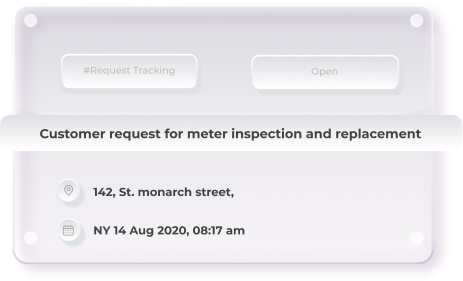Revolutionize field service management with SEW’s Tech-En-Route, ensuring connected customer and workforce experiences. Enjoy seamless, real-time engagement through GPS-enabled live tracking, interactive map views, precise ETAs, and instant communication options. With the platform, benefit from multichannel communication and integrated GIS insights that boost transparency and performance metrics, while AI/ML-powered analytics drive smarter, data-driven decisions. Route optimization, powered by location intelligence, ensures on-time and efficient service delivery. Enhance workforce engagement with AI-driven route optimization, offering convenient appointment scheduling, real-time updates, and direct interaction with field workers.
Revolutionize Customer-Workforce Experience with Real-Time Connectivity
Provide customers with interactive map, precise ETAs, and detailed technician profiles. Empower control over scheduling, manage late arrivals, and ensure rescheduling efficiency. Elevate customer safety by offering complete field worker details, ensuring transparency and peace of mind.
Maximize Efficiency with Tech-En-Route’s Innovative Route Optimization
Harness location intelligence for intelligent scheduling and dispatching. Elevate customer experience with self-service booking, real-time updates, and seamless communication with Predictive analytics drive proactive service excellence.
AI/ML Analytics for Optimized Field Supremacy
Unlock the power of AI/ML with advanced dashboards displaying GIS data predictions, SLAs, field worker performance, and location data analysis through comprehensive reports. Make informed, data-driven decisions to enhance performance metrics and ensure efficient service delivery operations.
Elevate Field Service Efficiency with AI/ML powered Tech-En-Route
The uberization of the service sector is now a reality. Utility customers demand to know the status updates on their service requests and maintain direct contact with the field personnel. To ensure operational efficiency and maximize performance, utilities also need visibility of the field workforce.
Enhanced Visibility and Efficiency
Experience unparalleled visibility with GPS-enabled live tracking. Monitor your field workforce in real-time, ensuring optimal deployment and swift responses, leading to increased efficiency and productivity.
Enhance Customer Engagement
Connect with customers via multichannel alerts through email, text, push notifications, and chatbots. Share timely updates and real-time location info for higher satisfaction and loyalty.
Data-Driven Performance Boost
Use tracking for deep insights into field activities. Optimize operations, improve service, and reduce costs with data-driven decisions.
Optimized Operations with Route Optimization
Achieve significant improvements by optimizing travel routes, refining maintenance schedules, and enhancing the entire service chain. These enhancements lead to cost savings and more efficient service delivery.
Seamless Integration and Flexibility
Integrate effortlessly creating a unified and streamlined service experience, allowing for greater flexibility and enhanced operational efficiency.
Making the Connection TheConnected CX-WXfor Utilities
- Efficient Work Order Management
Admins swiftly create, schedule, and dispatch work orders with SmartWX. AVL tracking ensures seamless fleet management and resource allocation.
- Empowered Field Service Agents
Field workers get optimized routes and real-time updates via GIS integrated smart maps, enabling efficient job completion without unnecessary stops.
- Engaged Customers
Customers receive instant notifications and ETAs for field service agents. Live tracking on GIS-integrated maps and real-time updates enhance satisfaction and reduce anxiety.
- Insightful Utility Operations
Admins enjoy real-time visibility into operations, monitoring job status and field worker locations from their desks, enabling proactive management and continuous improvement.
Platform Benefits
- 50%Reduction in SLAs
- 48% - 52%Increase in Operational Efficiencies
- 80%Increase in First Time Fixes
- 100%Reduction in Paperwork and Manual Processes
Solutions for Your Industry
Electricity
Revolutionize your energy operations with Tech-En-Route! Minimize outage impact with rapid response, proactive customer communication, and optimized crew dispatch. Boost grid reliability and cut costs through data-driven insights. Build customer trust with transparent technician profiles.
Gas
Strengthen your gas operations with Tech-En-Route! Ensure rapid response during emergencies, proactively communicate with customers, and optimize field crew deployment. Improve operational efficiency, reduce costs, and prioritize pipeline maintenance for enhanced safety and customer trust.
Water
Tech-En-Route empowers your water utility to deliver uninterrupted service. Swiftly address leaks and disruptions, keep customers informed, and optimize resource utilization. Gain valuable asset insights and reduce maintenance costs while building customer confidence with transparent operations.
Telecom
Elevate your telecom field service to new heights with Tech-En-Route! Maximize network uptime, delight customers with proactive communication, and optimize technician deployment. Gain deeper insights into your operations, reduce costs, and build customer confidence through transparent service.
Frequently Asked Questions
.accordion-body, though the transition does limit overflow..accordion-body, though the transition does limit overflow..accordion-body, though the transition does limit overflow..accordion-body, though the transition does limit overflow..accordion-body, though the transition does limit overflow..accordion-body, though the transition does limit overflow..accordion-body, though the transition does limit overflow..accordion-body, though the transition does limit overflow..accordion-body, though the transition does limit overflow..accordion-body, though the transition does limit overflow.


